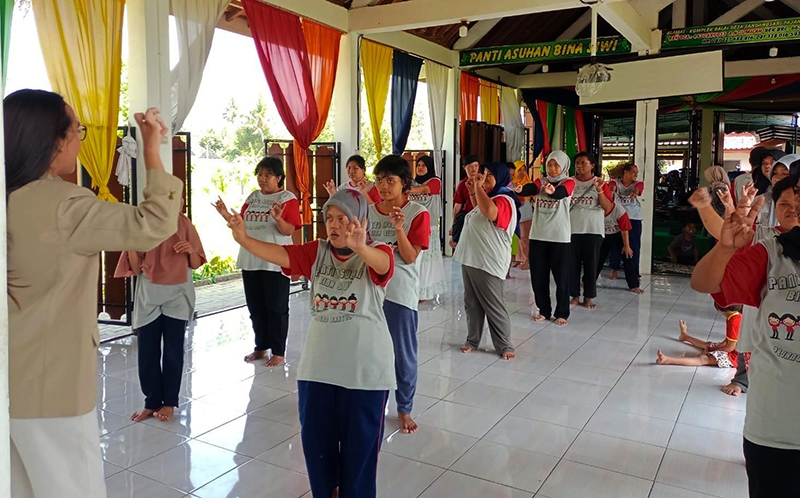
A UGM student team conducted a social project to serve the community at the Bina Siwi Orphanage in Yogyakarta.
The team sought to change the inclusive perspective of children with disabilities by creating a space for expression through dance and music.
It comprises Muhammad Jhony Fonsen (Tourism 2020), Revana Sheba Pavita (Nursing 2020), Regizki Maulia (Psychology 2021), Hakam Tsaqib Hanafia (Indonesian Literature 2021), and Fahrezy Thomas Pratama (Chemistry 2022).
Before commencing their community service project, the students, under the guidance of Dr. Hayatul Cholsy of the Faculty of Cultural Sciences, conducted a survey and observed that the vision and mission of Bina Siwi Orphanage had yet to be fully realized.
This was evident in artistic activities, as Bina Siwi Orphanage had not yet wholly facilitated the needs of children with disabilities.
The vision of Bina Siwi Orphanage is to improve the welfare of children with special needs and provide structured, continuous training to promote self-sufficiency. The orphanage aims to enhance its vision with the support of seven missions.
One of these missions is to optimize the potential of children with special needs within the orphanage, emphasizing ongoing, structured skill development activities to prepare them for the future.
“Two out of seven missions have been established as the foundation, but it has not been realized maturely and optimally at the Bina Siwi Orphanage,” said Muhammad Jhony Fonsen at the UGM campus on Friday (October 13).
Sugiman, Chair of the Bina Siwi Orphanage Foundation, explained that the orphanage had made efforts to provide artistic facilities for the children.
However, there were additional challenges in the form of financial constraints that prevented them from bringing in instructors.
As per the vision and mission, Bina Siwi Orphanage aspires to guide children’s abilities toward independence and well-being, such as providing training in sewing, animal husbandry, and even egg production.
However, activities related to the arts could not be carried out optimally. The orphanage indeed dreamed of having an artistic group with a distinct character that could welcome guests or enliven various events.
“We often receive visits from various groups, and as we progress, I have high hopes of improving the orphanage’s value by building a clear identity through an artistic group. But once again, the challenge is that we don’t have instructors for the arts, both dance and music,” Sugiman stated.
In response to the orphanage’s needs, the team introduced the “TOK-SHOW OBAH: Self-Actualization of Individuals with Disabilities in Art through Dance Accompanied by Traditional Toys” program.
The TOK-SHOW OBAH program aims to create a system to enhance the orphanage’s identity, provide a space for expression for people with disabilities, and serve as a platform for self-actualization.
Hakam Hanafia explained that this program combined music and dance. Interestingly, the team experimented using an unusual musical accompaniment for dance: traditional toys that make otok-otok sounds.
These toys became not just playthings but also had high educational and creative value in experimental music performances.
“Besides being affordable, these otok-otok toys are also widely available in Yogyakarta, especially in the Bantul area,” said Hanafia.
“At an affordable price, these traditional toys have multiple functions. This contributes to preserving traditional toys in today’s era and offers high educational and creative value.”
Regizki Maulia added that the variety of dance movements taught was also diverse, in addition to using unconventional musical accompaniment.
In this work, the team incorporated easy dance movements characteristics of Yogyakarta’s style, such as ngeruji, ngithing, and ukel, as well as sign language used for greetings such as “Hello,” “Thank you,” and “I love you.”
Through these dance movements, Maulia explained that they aimed to demonstrate that people with disabilities can still receive an education tailored to their skills and capabilities.
One such aspect of educational enrichment comes from dance training.
“Interestingly, from a psychological perspective, practicing dance and music for children with disabilities, especially those with hearing impairments, can serve as a form of therapy,” Maulia expressed.
Revana Pavita and Fahrezy Pratama were grateful because the participants were highly enthusiastic about practicing to create collaborative work.
With the introduction of this program, they could create, express, and actualize their abilities even though they did not have access to artistic facilities.
“The participants responded positively to the program and hoped it would be completed according to the orphanage’s needs. They also hoped that the program would not stop as a Student Creativity project but become a sustainable activity,” said Pavita.
Author: Agung Nugroho

